Heads Up For Safety

A helmet is designed to work once only
It didn’t seem like a life-altering event at the time. But about 10 days after returning to Minnesota from the annual snowmobile photo/test ride session in West Yellowstone, normally frigid Minnesota enjoyed a rare Spring-like day that invited me to fire up my Harley-Davidson for a prematurely early ride in the sunshine. Little did I know that seemingly inconsequential decisions made in preparation for that ride would make a difference.
Choices matter. Everything matters. Like choosing to wear the heavier leather motorcycle jacket instead of the mid-weight one. Deciding to layer with a fuzzy, soft fleece pullover underneath the jacket. Instead of lightweight shoes, which would be fine for a short hour or two ride, the decision was to wear full-on Tourmaster all-weather biker boots. Full-finger gloves would be warmer than fingerless ones. And, a crucial decision would turn out to be the choice of helmet.
Like many powersport enthusiasts, I have about a half-dozen helmets ranging from a half-helmet with removable neck curtain to a couple of high-tech Bombardier modular ones with flip up inner shield. And then there are the three Shoei open-face RJ-Platinum models. There’s a beat-up white one that gets used for snowmobiling once in a while. It had been first choice but time and wear relegated it to third-string. There’s a not-so beat-up black one that goes on sled tests. And there’s another black one — it’s newer — and needs to be replaced. It did its job.
One Time Use
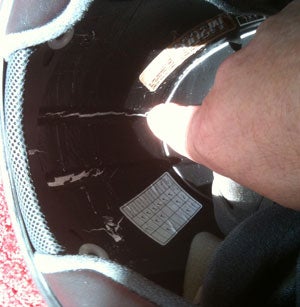 The cracks in the inner liner resulted from the outer shell distributing the impact of the crash.
The cracks in the inner liner resulted from the outer shell distributing the impact of the crash.It seems strange that we motorsports people will pay upwards of US$750 for a product that can be used safely only once. It’s the conundrum a helmet poses.
But when you need a helmet’s function, trust me, you won’t be thinking about the price per usage. You want your helmet to work as designed. Mine did.
My nice day’s motorcycle ride ended with my Harley a crumpled wreck at the side of a two-lane highway and with me lying a tossed and broken wreck 35-feet further on in a Wisconsin ditch. It would be a month before I understood how well my helmet worked.
My son told me how the outer shell looked. There was a dent on the back and serious road rash scratches by the right ear.
It was a month after the crash when my wife described the inner shell of that Shoei. That outside shell dent covered double cracks under the fabric liner. My wife didn’t understand what that meant, but I did. It made my week in intensive care at the trauma center and another week on the hospital’s broken bone floor and the total of six operations to salvage my right leg seem almost minor. Without that helmet, it’s unlikely that I’d be writing this right now. No, thanks to the decision to wear my dedicated for motorcycling black helmet, I’m able to wait out the three to four months before being ambulatory again. For now it’s my wheelchair and me. Although I do check to see if there’s room to fit a tiny V-Twin to it.
 Snowmobilers wear helmets for safety as well as keeping warm.
Snowmobilers wear helmets for safety as well as keeping warm.Anyway, don’t worry; I’m not going to turn into one of those crusading pro-helmets fanatics. There’s too much “Live Free or Die” New Hampshire breeding in me for that. Still, it is chilling to see how many people ride motorcycles without helmets.
As for snowmobilers, cold weather plays a key role in having the majority of us wearing helmets. Helmets satisfy our need to keep our ears and heads warm. Safety is a nice side benefit.
Helmet 101
Once I realized how the helmet saved my head from being a capsule for brain mush, it seemed only natural that a bit of research needed to be done. Like most of us, I understand the basics. The helmet is designed to withstand impact. But according to Shoei virtually all pieces of a helmet play a role in protecting your head.
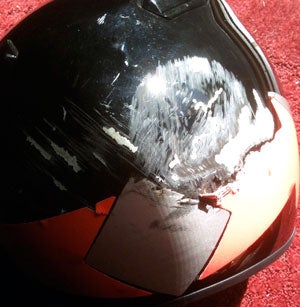 A helmet’s outer shell is engineered to absorb and redistribute impact.
A helmet’s outer shell is engineered to absorb and redistribute impact.The helmet shell absorbs the impact energy in the event of a fall or crash and distributes it over the largest possible area. In Shoei’s case the outer shell’s construction combines fiberglass with organic fibers that result in a stronger, lighter shell that will absorb and distribute the force of an impact safely and efficiently.
As was demonstrated with my helmet, the energy of a severe impact is passed from the helmet shell to be absorbed by the deformation of the inner liner, which is designed to absorb the energies of a single one-time impact.
Even the chinstrap plays a role in minimizing crash impact. Using a chinstrap with proper tensile strength and extensibility will hold the helmet firmly on your head. This also includes using metal rivets to firmly attach the chinstrap to the helmet shell.
With a severe hit like the one my helmet took, it’s pretty obvious that the helmet needs to be replaced. Every quality brand helmet manufacturer offers similar advice as to when a helmet should be replaced. Shoei offers four reference points for when to replace a helmet: • There was a fall that resulted in an impact on the helmet. • The helmet fits looser than when it was purchased due to frequent use. • The liner has come away from the helmet shell. • The liner shows signs of wear and is beginning to break up, or if it has been exposed to heat or a solvent and has melted.
The maker of popular snowmobile helmets, HJC America further advises that you replace your helmet every 4 to 5 years. Even if your helmet has not been damaged, over time UV rays and adhesive and component aging will damage your helmet and increase your risk of serious injury in an accident.
In addition HJC notes that you should never drop your helmet as it may crack the shell or damage the protective foam. As HJC notes, your helmet is only designed for ONE impact.
Buying A Replacement
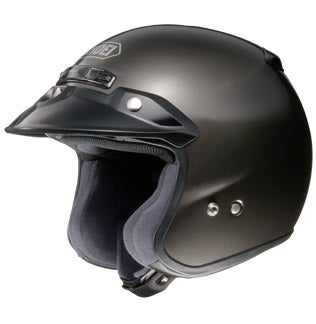 Shoei’s RJ-Platinum has an outer shell that combines fiberglass with organic fibers to create a stronger, lighter shell to absorb and distribute the force of an impact safely and efficiently. (Image Courtesy Shoei Helmets)
Shoei’s RJ-Platinum has an outer shell that combines fiberglass with organic fibers to create a stronger, lighter shell to absorb and distribute the force of an impact safely and efficiently. (Image Courtesy Shoei Helmets)HJC adds that when you replace a helmet and buy a new one, you should destroy the old one to ensure it cannot be reused.
When buying a new helmet in the US or Canada, look for the D.O.T standard. Helmet manufacturer AFX North America Inc. explains that In North America DOT FMVSS-218 is the most common standard. This design standard is administered by the U.S. Government and is mandatory for every motorcycle helmet sold in the United States and Canada.
While I mentioned spending upwards of $750 for a full-face helmet, that’s for a racer-quality model. I didn’t spend anywhere near that for my open-face model, nor will I for its replacement. You can find quality DOT-qualified helmets at various price points. If you look at the variety of snowmobile gear outlets offering discounted helmets on the internet, you’ll find that you can purchase top quality at great value.
Remember that a helmet needs to do its job just once. Mine did and I’m grateful. I’ll see you back on the roads and trails as soon as my beat-up body lets me. But for now, take my word for the value of good headwear.
Related Reading How to Find the Best Headgear Looking Safely Ahead



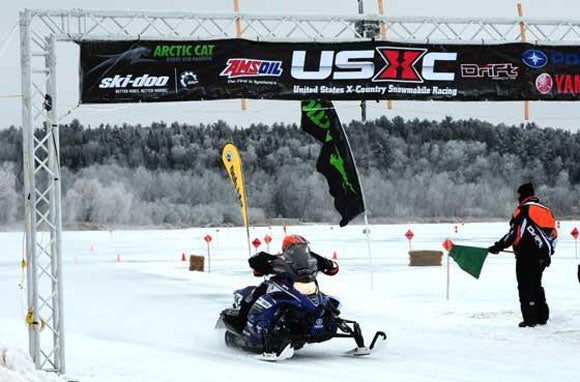
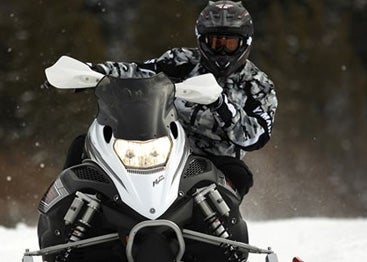
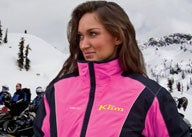


 Your Privacy Choices
Your Privacy Choices